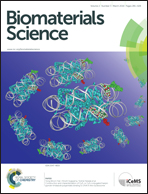Hydrogelation of dextran-based polyampholytes with cryoprotective properties via click chemistry†
Abstract
Hydrogels are promising substrates for tissue engineering applications because of their unique biocompatibility, flexible methods of synthesis, range of constituents, and desirable physical characteristics. Cryopreservation of cell-containing constructs using such hydrogel scaffolds is in high demand in tissue-engineering applications for the production of “off-the-shelf” tissue-engineered products. However, cryopreservation of regenerated tissues including cell sheets and cell constructs is not easy compared to the preservation of cell suspensions, even when cryoprotectants are used. Here, we report a dextran-based polyampholyte hydrogel that itself shows cryoprotective properties, which could be useful for cell encapsulation and tissue engineering applications involving hydrogel formation. Amination was performed by introducing poly-L-lysine onto azide groups conjugated with dextran, and a portion of the amino groups was converted into carboxyl groups. These dextran-based polyampholytes showed good cryoprotective properties for mammalian cells, and the addition of dextran substituted with dibenzylcyclooctyne acid induced in situ hydrogel formation via Cu-free click chemistry with high biocompatibility. Cells encapsulated with such in situ hydrogels can be cryopreserved well without the addition of any cryoprotectants. Thus, these hydrogels can serve as scaffolds with cryoprotective properties that also provide structural integrity to tissue constructs.


 Please wait while we load your content...
Please wait while we load your content...